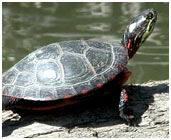Turtles are amazing aquatic creatures that are known to have existed since millions of years. Check out interesting facts and information on turtles.
Facts About Turtles
What first crosses your mind when you think of turtles? Do you picture them lumbering around slowly? Or do you picture their bald heads and their oval-shaped shells? Turtles are magnificent creatures that have stood the test of time and are now, one of the most endangered species around the world. Turtles are fascinating creatures of the sea that resemble tortoises and are excellent swimmers. Their soft bodies are protected with a heard shell and they have highly developed flippers that help them swim in strong ocean currents. Turtles are known to be one of the oldest reptile groups inhabiting the earth, with the earliest turtles dating back almost 215 million years. There are around 300 species alive in the present day world and many of them are included in the endangered species list. Today, many people prefer to keep turtles as exotic pets and rigorous conservation programs are going on around the world to protect this fascinating creature. Check out some really interesting facts on turtles given below.

Fast Facts
Scientific Name: Testudines
Kingdom: Animalia
Phylum: Chordata
Class: Reptilia
Order: Testudines or Chelonii
Suborders: Cryptodira, Pleurodira, Proganochelydia
Family: Adocidae
Genus: Australochelys
Origin: Late Triassic period
Diet: Plankton, Algae, Snails, sea grass, small insects (omnivorous diet)
Length: Average 8-45 inches
Weight: 4-15 kgs
Natural Habitat: Sea
Lifespan: 100-120 years
Type: Cold-blooded
Status: Extremely endangered
Age of Maturity (females): 4-10 years
Age of Maturity (males): 10-15 years
Gestation Period: 10 weeks
Number of Offspring: 100-150 eggs
Interesting And Amazing Information On Turtles
-
It has been more than 200 million years since turtles have inhabited this earth. They were the first ones to have evolved much before different species of crocodiles, mammals, birds, snakes and even lizards!
-
The very first turtles had teeth and unlike the turtles of today, could not pull in their heads. Apart from this, the turtles we see today are very much the same as the earliest ones.
-
Many species of turtles can live upto a 100 years, including the American Box Turtle. In an amazing documentation of an adult Indian Ocean Giant Tortoise, it was captured when it was around 50 years old and survived a staggering 152 more years in captivity!
-
You can find turtles on almost all continents except Antarctica. Most turtles don’t adapt too well in cold regions but one specie known as Blanding's turtle has been seen swimming under ice in Great Lakes region.
-
Turtles come in a huge variety of sizes. The smallest one is the 4 inch Bog turtle and the largest one is the 1500 pound Leatherback turtle.
-
The domed top part of the shell of a turtle is known as carapace and the underlying soft part is called plastron.
-
The shell of a turtle itself is made up of almost 60 different bones, which are connected all together, making it hard and strong. The bony area of the shell is covered with plates known as scutes that are derived from the skin and offer strength and protection.
-
Male turtles sniff the tails of female turtles to find a potential mate.
-
Turtles are known to possess excellent eyesight and a keen sense of smell. Hearing and sense of touch are both good and in fact, the shell also contains nerve endings!
-
Certain species of aquatic turtles can absorb oxygen through skin pores on the neck, which allows them to remain underwater for long durations. They also tend to hibernate under water due to this feature.
-
Contrary to popular belief, the shells of turtles are also a very sensitive part on a turtle’s body. The shells have nerves embedded in them and a constant blood supply as well. Thus, if a turtle is cut or is injured on the shell, it is said that they bleed heavily and also feel excruciating pain.
-
Funnily, tortoises were the first to orbit the moon before humans. In 1968, the Soviet Union launched a space probe with a spacecraft that carried a number of turtles.
-
A carnivorous turtle called the snapping turtle is also one of the most feared turtles. They have sharp-hooked beaks, bear claws and alligator-sharp teeth. These turtles usually feed on snakes, clams and crayfish.
-
Did you know that turtles don’t have vocal cords? The interesting bit does not end here. Even though they don’t have vocal cords, they can still make noises.


See also
More from iloveindia.com
- Home Remedies | Ayurveda | Vastu | Yoga | Feng Shui | Tattoos | Fitness | Garden | Nutrition | Parenting | Bikes | Cars | Baby Care | Indian Weddings | Festivals | Party ideas | Horoscope 2015 | Pets | Finance | Figures of Speech | Hotels in India : Delhi | Hyderabad | Chennai | Mumbai | Kolkata | Bangalore | Ahmedabad | Jaipur
- Contact Us Careers Disclaimer Privacy Policy Advertise With Us Lifestyle Sitemap Copyright iloveindia.com. All Rights Reserved.



